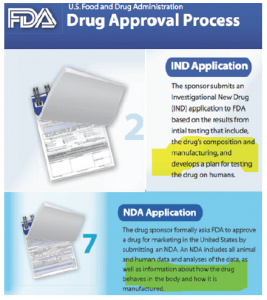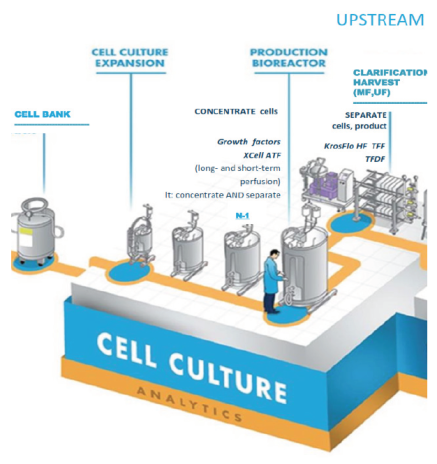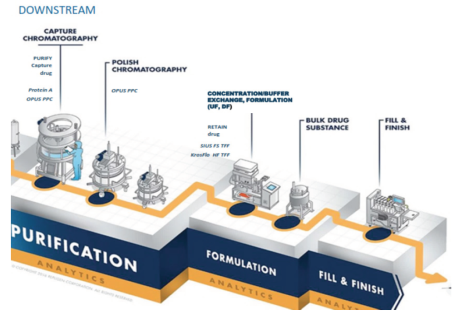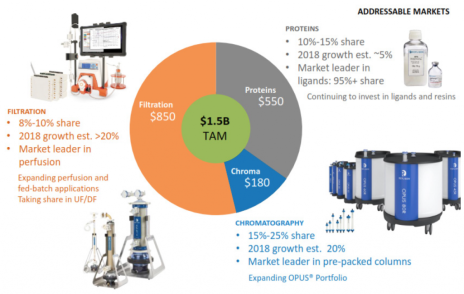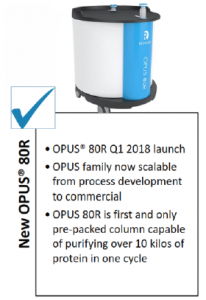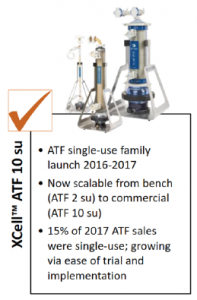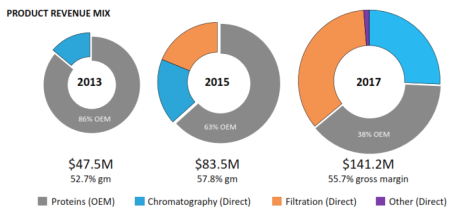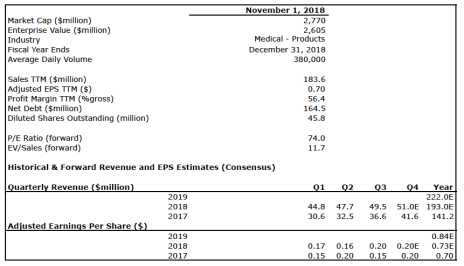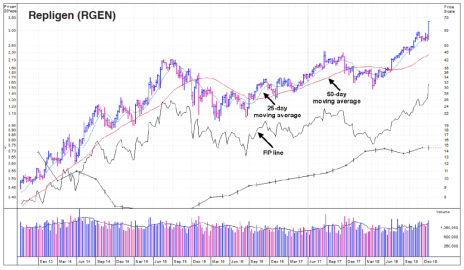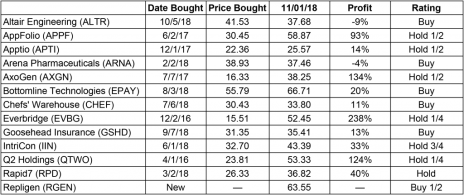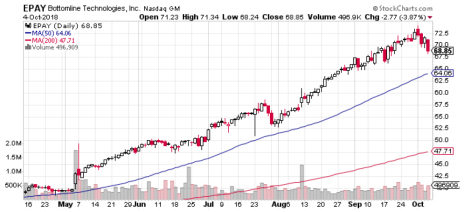October proved to be a challenging month for stocks, but one good thing came out of it—it helped me identify stocks that investors really want to own!
Cabot Small Cap Confidential 234
[premium_html_toc post_id="163250"]
THE BIG IDEA
A lot of attention is given to the companies that develop blockbuster drugs. Far less attention is paid to those that make the sophisticated manufacturing equipment that allow drugs to be developed, made for clinical trials, then produced at scale when finally approved.
These manufacturing technologies and processes are so critical to a drug’s potential success that detailed specifications are included on the applications drug companies submit to the FDA (and European Medicines Agency) throughout the development and marketing process.
When potential treatments finally get into late-stage trials this manufacturing process has largely been set in stone. Changing it risks delays and setbacks – or even trial failures.
That can wreak havoc on a drug company that was hoping to finally cash in after years of hard work and millions of dollars of investment.
Given the hugely strategic role drug manufacturing processes and equipment plays, the companies that provide them tend to have extremely loyal customers.
Nowhere is this truer than in the booming biologics drug market. Biologic drugs are products produced from living organisms or that contain components of living organisms.
Biologic drugs are at the cutting-edge of biomedical research. They just might be the most effective treatments for conditions that currently have no cure.
There are 400 biologics in various stages of clinical development for conditions ranging from asthma to migraines to Alzheimer’s disease. And in 2017 the FDA approved a record number of 14. Beyond biologics, there’s also a wave of biosimilars waiting to hit the market. These are the “copycat” or generic forms of the biologics first approved by the FDA years ago.
Most of the best-selling drugs on the market are now biologics, including Humira (AbbVie), Rituxan (Roche), Enbrel (Pfizer/Amgen), Herceptin (Roche) and Avastin (Roche). Their effectiveness is making biologics one of the fastest-growing areas of the pharmaceutical market with estimated global sales of $200 billion in 2018 jumping to $250 billion by 2020.
The only catch is that biologics are not easy to make.
They are complex mixtures that are heat sensitive and susceptible to microbial contamination. Making them requires more precision and technology than required to make conventional drugs.
It’s often said that with biologics, the product is the process.
That’s why we’re investing in a company that makes the equipment biologic drug developers and manufacturers need to get their treatments to market.
This company, a critical supplier of bioprocessing technologies, is the real winner in biologic drug development as it generates revenue whether a drug succeeds or fails. And it wins when drug production ramps up, as is the case with many biologics right now.
THE COMPANY/PRODUCT
Repligen (RGEN) is a pure-play supplier of bioprocessing technologies that make it more efficient to manufacture biologic drugs, while ensuring high quality and safety standards. It is a leader in areas such as filtration, pre-packed chromatography columns and Protein A ligand manufacturing. These solutions help customers overcome capacity, cost, quality and time pressures. That is why Repligen is a leader in its field. It has a market cap of $2.6 billion.
Repligen is as much a partner as a supplier to its customers given the heavily regulated nature of bioprocessing and the strategic importance its products play in the drug approval and manufacturing process. Its solutions help set a higher bar for making complex treatments, including monoclonal antibodies (mAbs), recombinant proteins, vaccines and gene therapies.
Customers are large biopharmaceutical companies and contract manufacturing organizations, including GE Healthcare and MilliporeSigma, which accounted for 21% and 18% of revenue, respectively, in 2017. Repligen also does business with life science companies, diagnostic companies and laboratory researchers. This 60/40 mix of clinical and commercial exposure gives Repligen a relatively stable, long-term growth profile.
In 2017, 43% of revenue came from the U.S., 20% came from Sweden, 4% came from the U.K. and 33% came from the rest of the world.
Repligen is far from the biggest player in the bioprocessing technology industry. That honor goes to companies like Danaher (DHR), GE Healthcare (GE) and Thermo Fisher Scientific (THO). But Repligen is nimble. It has proven its mettle by picking battles wisely, focusing on areas of the market where there is less competition and where it can deliver superior products.
Two shining examples are illustrated by Repligen’s aggressive move into single-use technologies, and the 2017 acquisition of Spectrum, which added filtration technologies and sales force power.
Evolution of a Pure-Play Bioprocessing Supplier
Repligen has been around for almost 40 years. It was founded back in 1981 by two MIT professors, Alexander Rich and Paul Schimmel, and was initially focused on drug development and sales of bioprocessing products. Its scientists first cloned the gene for Protein A in 1982 and Repligen introduced the world’s first recombinant form of the ligand in 1985. Even today, most of the world’s monoclonal antibodies (mAbs) are purified on Repligen’s Protein A.
The company chugged along, selling Protein A ligands for years. Then it made a big acquisition in 2011 (Novozymes Biopharma) and significantly expanded its proteins product portfolio.
In the middle of 2012 the company fully exited the drug development market and became a pure-play bioprocessing technology company. Over the last six years management has proven to be astute acquirers of strategic technologies and talented integration artists, not to mention good at internal R&D.
Here are a few notes on technologies that Repligen has acquired over the years:
Refine Technologies, $24.5 million, June 2014: Acquired the XCell ATF System which increases product yield during the fermentation step of the biologic drug manufacturing process.
Atoll GmbH, $25.3 million, April 2016: Atoll brought a complementary line of pre-packed chromatography columns into the fold and helped Repligen expand into screening and process development labs.
TangenX, $37.1 million, December 2016: Brought in a portfolio of innovative single-use flat-sheet tangential flow filters (TFF) and cassettes to complement Repligen’s line of pre-packed chromatography columns, both of which are used in downstream manufacturing processes.
Spectrum, $370 million, August 2017: Expanded Repligen’s addressable market by over 50% and provided diversification and a broader portfolio of Filtration offerings. Also doubled the sales force.
The net result is that Repligen has evolved from a Protein A supplier to a diversified bioprocessing solution provider with best-in-class technologies, double-digit revenue growth and expanding EPS.
That’s a magical combination!
A Crash Course In How Repligen is Changing Biologic Drug Manufacturing
The biologic drug manufacturing process can be broken into two broad areas: upstream manufacturing and downstream manufacturing.
Upstream manufacturing is where materials are extracted to be used later when it’s time to add ingredients into the mixing pot. During this step biologics are produced by living cells growing in a bioreactor. These cells are very sensitive to their growing conditions and toxic wastes build up as cells grow and metabolize. When a culture reaches a steady state it is moved to a larger bioreactor where nutrients go in and wastes come out. Healthy cells can grow, and production can be scaled up.
A biomanufacturer wants to achieve as much cell density in a fixed-capacity bioreactor as possible to get the most bang for their buck. To boost yield, growth factors are added to the cell culture media. This is like a farmer fertilizing plants.
The industry standard cell “fertilizer” is insulin. Repligen makes insulin-like growth factors (IGF) that are up to 100 times more biologically potent. Imagine putting the equivalent fertilizer on your tomatoes!
Historically, most biomanufacturing (80% as of 2016) was done using a fed-batch process where nutrients go in at the beginning and during the fermentation process and the batch of cell culture stays in until the end.
Repligen sells this technology but has also been peddling alternating tangential flow filtration (ATF) techniques in which the cell culture media with the biologic product is continually removed, and replaced with fresh media, throughout the production run. This means continuous harvesting is possible, along with continuous waste removal. The result is a longer process run of one to three months, versus just one to two weeks with a fed-batch process.
Suffice to say, IGF and ATF technologies boost yield and reduce costs. Even better, they allow for more flexible production capacity tuning, smaller bioreactors to achieve the same yield (i.e. lower costs) and more consistency, better quality, and less contamination risk. These kinds of win-win-win innovations are why many biomanufacturers believe Repligen’s technologies represent the future in biologics/biosimilar upstream manufacturing.
Downstream manufacturing steps include clarification, purification, filtration and formulation/packaging. Clarification is a mechanical process that removes cell debris and water from the broth, leaving a highly concentrated clear broth that is ready for purification. It is done through centrifuge and depth filtration, or cross-flow microfiltration.
The clarified broth then moves on to the purification step to remove all contaminants and be condensed to 90% to 100% product concentration. The key process is chromatography, during which the broth passes through a chromatography column packed with a special media. The industry standard media for purification of monoclonal antibody (mAb) based therapeutics is Protein A affinity resin. Because of Protein A’s ability to capture antibodies, the mAb product is highly purified and concentrated during this step.
Protein A resins are packed into a chromatography column, of which there are usually three. The industry is shifting from permanent glass columns to pre-packed chromatography (PPC) single-use columns, especially in early-stage clinical manufacturing. Single-use columns offer lower cost, convenience, consistency and speed. These are what Repligen sells.
Next is filtration, which makes the mAb product even more pure. It’s common to use flat-sheet tangential flow filters (TFF) and cassettes to separate and purify biomolecules at lab-scale and large-scale biopharmaceutical manufacturing. TFF is like the cross-flow filtration in the clarification process but has a much smaller filter membrane.
In the last step of the downstream process the purified biologic drug is formulated, checked for quality, and packaged into the final form that will be given to a patient.
There are two major ways in which Repligen is advancing biologic drug manufacturing:
Single-use Technologies
Single-use technologies are growing rapidly in the bioprocessing industry because they increase the speed, safety and cost effectiveness of developing and manufacturing drugs. Just like doctors don’t want to reuse a needle or syringe on different patients, research labs and drug manufacturers don’t want the risks associated with sterilizing and reusing bioprocessing supplies.
Single-use technologies also mean less capital is tied up in facilities—especially stainless steel and steam-cleaning systems—and space. Capital investment for single-use technology can be 30% to 40% less than stainless steel. It also permits scaling production up or down to meet manufacturing demand.
This is well suited to advancements in personalized medicine, targeted therapies and stronger dosing, all of which require flexible manufacturing of what are often small batches. Because single-use requires specific process parameters designed around the technologies used, suppliers like Repligen enjoy good revenue visibility.
Technology Leadership
Repligen has some of the best technologies in the bioprocessing industry, including single-use alternating tangential flow filtration and pre-packed columns. This technology leadership is the result of internal development, strategic acquisitions (Spectrum was a big one) and, most recently, strategic partnerships (i.e. Navigo Proteins and Sartorius).
The big picture strategy here is to establish technical superiority in niche markets, with limited competition, to further cement Repligen’s status as an integrated supplier of mission-critical equipment that solves customers’ problems.
Let’s talk about each of these products lines.
The Products & Technologies
Repligen believes its target markets are worth around $1.5 billion annually, broken down according to the pie chart in the accompanying image. It is a clear market leader in Proteins (over 95% market share) where it has a near monopoly. And Repligen is coming on strong in both Chromatography and Filtration, which are both growing at over 20% in 2018.
Repligen isn’t planning to sit still; management continues to drive the business forward with new products hitting the market this year and next. And you can bet there are acquisition targets out there as well.
OEM Products
Proteins
Protein A Ligands are an essential binding component of Protein A chromatography resins used to purify most monoclonal antibody (mAb) based drugs. Repligen makes seven Protein A ligands for major life sciences companies (GE, MilliporeSigma and Purolite), who then sell their Protein A chromatography resins to mAb manufacturers. Manufacturing sites are in Sweden and Massachusetts.
In June 2018 Repligen secured an agreement with Navigo Proteins to co-develop multiple affinity ligands for which Repligen will hold exclusive commercial rights. The first of these, NGL-Impact A, will be supplied exclusively to Purolite Life Sciences and will compete with PrismA (the new Protein A chromatography resin that GE will make itself, see “Risks”), but at a much lower price. Repligen management has said it expects to release new Proteins roughly every 12 to 18 months. This is a major development as it should help Repligen grow its Proteins business.
Growth Factors
Repligen’s growth factors are often added to cell culture fermentation media to stimulate cell growth and increase yield from a bioreactor during upstream processes. Repligen acquired several cell culture growth factor additives when it acquired Novozymes in 2011, including one (LONG R3 IGF-1) that is 100 times more biologically potent than insulin, which is the industry standard.
Direct-to-Customer (DTC) Products
Chromatography
Chromatography products are used in the downstream purification and quality control of biological drugs. The big growth driver here is the OPUS brand of pre-packed chromatography (PPC) single-use columns. PPC columns are sent to customers with their choice of chromatography resin so biomanufacturers enjoy the benefits of customizable “plug-and-play” convenience to match their purification needs.
The first production-scale OPUS column launched in 2012 and Repligen has since added larger varieties (plus one smaller one), as well as resin recovery and unpacking port features, to broaden its market potential and better differentiate the brand. The company also makes a variety of chromatography resin, branded as CaptivA, and ELISA kits, an analytical test kit to detect the presence of proteins and growth factors.
Filtration
Filtration products are used to make biologic drugs at the appropriate scale, whether for pilot studies, clinical studies or commercial production. Repligen has been building out its filtration product line through several acquisitions since 2014.
It is also accelerating filtration growth through strategic partnerships such as the recently announced one with Sartorius (non-exclusive) to introduce a next-generation perfusion-enabled bioreactor that brings XCell ATF control tech into Sartorius’ BIOSTAT line. Sartorius will sell and support the equipment (launching late next year or early 2020), meaning Repligen expands its market without requiring a lot of investment.
XCell ATF is a range of alternating tangential flow filtration (ATF) devices used in upstream processing to remove cellular metabolic waste products during a fermentation run. They help healthy cells focus on producing the desired biologic drug. XCell ATF Systems increase cell densities by two to three times that of standard batch fermentation, thereby boosting yield and/or reducing the size of the bioreactor required to achieve the desired output. Repligen began selling single-use stainless steel XCell ATF devices in 2016 which can cut implementation time by 80% and reduce costs.
Sius TFF (TangenX) is a portfolio of single-use, flat-sheet tangential flow filters (TFF) and cassettes used in downstream biologic drug purification and formulation processes. These products reduce labor and product costs as compared to reusable TFF products, and they are interchangeable with filter hardware from other manufacturers.
Spectrum is a portfolio of leading hollow-fiber filters and modules, single-use flow path connectors and TFF filtration systems. They are used for the filtration, isolation, purification and concentration of biologics and diagnostic products. Spectrum filters can be used in Repligen’s XCell ATF system and expand the company’s market beyond monoclonal antibodies to include vaccines, recombinant protein and gene therapies. The portfolio is made up of the KrosFlo, Spectra/Por and Pro-Connex brands.
Moving forward, expect Repligen to continue to bring new technologies to market, acquire technologies, and improve upon the ones it already has.
The Business Model
Repligen manufactures and sells bioprocessing equipment to life sciences and biopharmaceutical companies. It sells chromatography and filtration supplies directly to customers. It also sells Protein A ligands through long-term supply contracts in its OEM business and has an exclusive co-development agreement with Navigo Proteins for multiple affinity ligands.
It enjoys sticky customer relationships due to the OEM contracts and the heavily regulated nature of bioprocessing, where technology suppliers are an integral part of the FDA application and approval process. Repligen’s growth model is driven by both internal R&D and acquisitions, with a focus on leadership in niche markets where competition is relatively low, and it can establish a technology edge.
The company has over 500 employees, with sales teams spread across the U.S., Europe and Asia, and manufacturing facilities in Massachusetts and Sweden. It has recently transitioned to a hybrid sales model where all sales staff sell products across the Chromatography and Filtration portfolios.
The Bottom Line
Repligen has grown revenue at an average annual rate of 31% for the past three years and EPS at an average pace of 38%. In 2017, revenue jumped 35% to $141 million while EPS soared 43% to $0.70. Trends in product revenue and the relative sales mix are shown in the three pie charts below.
Through the first three quarters of 2018 (Q3 results were released yesterday) revenue is up 43% while EPS is up $0.02 to $0.52. In the just-reported third quarter, revenue jumped 35% to $49.5 million while EPS jumped 33% to $0.20. Organic revenue growth was 24% while acquired growth from Spectrum was up 28% and contributed 27% of total revenue. Gross margin over the last nine months was 56.1%, relatively steady compared to 2017.
Management updated 2018 revenue guidance above consensus estimates ($188 million) to a range of $191 million to $194 million (implying 35% to 37% growth) and adjusted EPS above consensus ($0.71) to a range of $0.71 to $0.75. Adjusted gross margin is expected to be around 56%.
Repligen ended Q3 with $190 million in cash and equivalents, implying plenty of room for more M&A activity.
RISK
Customer concentration: GE Healthcare and MilliporeSigma accounted for a combined 39% of revenue in 2017 (down from 66% in 2015). Purolite is a new customer with significant potential. Repligen has contracts with GE through 2019 (in Sweden) and 2021 (in Massachusetts), MillipporeSigma through 2023 and Purolite through 2022. Revenue could be at risk if these customers don’t decide to renew their contracts.
In-Sourcing of Ligands: GE decided to in-source a resin starting in 2018 and could reduce purchases of ligands after contracts end. Other customers could do the same. That said, GE owns IP on supplies which puts it in a unique position to in-source.
Loss of Technology Leadership: Repligen has terrific technology today, but larger competitors could chip away at its technological edge over time and limit its market potential.
Acquisition Integration Risk: A good deal of Repligen’s current success is due to smart acquisitions and well-executed integration. Should that track record fail to hold up with future acquisitions (which are expected), future growth could be at risk.
Overseas Exposure: In 2017 20% of revenue came from Sweden, 4% came from the U.K. and 33% came the rest of the world. This opens Repligen up to foreign exchange fluctuations and other risks inherent to the markets where it does business. That said, bioprocessing is a global market, so there are clear reasons (i.e. over 50% of revenue!) why international exposure is good for Repligen.
COMPETITION
Repligen competes with four major companies in the bioprocessing equipment industry, all of which are diversified life science companies with bioprocessing technologies making up a small part of their overall business. They are: Danaher (DHR), GE Healthcare (GE), Merck (MRK) and Thermo Fisher Scientific (THO). A fifth company, Sartorius, generates roughly three quarters of its revenue from bioprocessing. Catalent (CTLT) is a mid-cap bioprocessing equipment supplier. There are also a few diversified industrial companies with fluid management and filtration solutions, including 3M (MMM), Asahi-Kasei and Parker Hannifin (PH). And there are a larger number of small, specialty players, many of which could represent acquisition targets for Repligen. BD Biosciences, DCI-Biolafitte, Infors and Meissner all fall into this last category.
THE STOCK
Trading Volume: RGEN has a market cap of $2.6 billion and trades an average of 380,000 shares ($20.5 million) daily. Our subscriber group won’t move this stock. The stock regularly trades over 500,000 shares in a day, and volume has exceeded that threshold 18 times over the last six months.
Historical Price: RGEN has been public for over two decades but didn’t do a heck of a lot until after the strategic re-focus began to bear fruit in 2013. The stock was strong through mid-2015 when it topped out around 42.5 then retreated to 20 during the mini-bear market. Momentum picked up in 2016 and RGEN broke out to new highs last summer. The hot streak was cut short when news of GE’s intent to in-source supplies raised concerns about the impact on RGEN. But as the market realized the potential impact was limited, and RGEN forged partnerships to strengthen its Protein business, shares firmed up and traded at all-time highs between 47 and 50 in July. The breakout came in August when RGEN rallied up to 59. It pulled back and spent October consolidating near its 50-day line (which is around 55). Following yesterday’s Q3 2018 earnings release RGEN jumped over 60 and closed at a 52-week high.
Valuation & Projected Price Target: Before reporting yesterday RGEN traded at about 13 times trailing 12-month revenue on an EV/Sales basis. Taking management’s guidance for 2018 revenue and assuming 15% growth in 2019 (likely conservative) and assigning a small valuation premium (15 times estimated 2019 revenue of $222 million) yields a price target of around 80.
Buy Range (next two months): Given the market volatility in October and RGEN’s big jump yesterday it’s especially important to average in to this position. Therefore, my buy range is quite wide, starting down near support at 52.5 and extending to 70. Monitor my summary in the Weekly Updates for the most recent rating on the stock. We will start with half a position in the Cabot Small-Cap Confidential Portfolio because of the recent jump. BUY A HALF.
The Next Event: Management just announced Q3 2018 results and should report Q4 results and give 2019 guidance in February 2019.
Repligen (RGEN) Financials
Repligen (RGEN) |
UPDATES ON CURRENT RECOMMENDATIONS
Due to the nature of the stocks recommended, it is to your advantage not to share these recommendations.
Buy means accumulate shares at or around the current price.
Hold means just that; hold what you have. Don’t buy, or sell, shares.
Sell means the original reasons for buying the stock no longer apply, and I recommend exiting the position.
Sell a Half means it’s time to take partial profits. Sell half (or whatever portion feels right to you) to lock in a gain, and hold on to the rest until another ratings change is issued.
After relinquishing all their year-to-date gains in October, the S&P 500 and S&P 600 bounced back this week and as of Thursday’s close were up 2.3% and 3.6%, respectively, on the year. Given a strong open Friday, the end-of-week returns could be better.
That’s an encouraging sign. Even more encouraging was the action in individual small-cap stocks that were oversold going into the week. After taking partial gains on many positions in October we’ve largely sat back and watched the action with reduced exposure. While we took some money off the table, the money we’ve left in has produced positive returns over the past week - our portfolio moved 4% higher.
Given the bounce it feels like it’s time to start picking away at select stocks again. But be forewarned!
With midterm elections coming up next week and a potential rate hike in December the market can go off the rails again quickly. As always, we’ll stick to our strategy, which means making incremental moves in and out of stocks as the tide shifts.
Our first move for the week is to start establishing a position in our newest stock, Repligen (RGEN). As I wrote in my introductory email, and in the Issue, start with a half position. The stock is doing very well now and should in the future. But after such a pop some weakness in the near term is likely. The only way to balance the risk and reward is to give yourself room to buy more on that weakness.
Back to the broad market, as I wrote two weeks ago, “… my current working hypothesis (which I reserve the right to change) is that this is a normal correction in the context of an ongoing, albeit old, bull market.”
If I’m right, the strength we’re seeing now is the beginning of a recovery process. That process will take time to work its way through. As it does we’re going to see more erratic action in individual stocks, both to the upside and the downside. Don’t read too much into these moves.
As just one example, you can look at Chefs’ Warehouse (CHEF). It was looking strong going into the report last night (which was just fine), then tanked at the open, retracing its mid-October move back down to 30! Soon after it bounced back and as of 10:00 a.m. was trading up 2% to 34.50. That’s a 13% swing in a matter of half an hour!
The action for us is far from over. On Monday we’ll have IntriCon (IIN), Everbridge (EVBG) and Goosehead Insurance (GSHD) report. Then Tuesday we hear from Rapid7 (RPD) and Q2 Holdings (QTWO), followed by Arena Pharmaceuticals (ARNA) on Wednesday. Earnings season winds down for us on Thursday when Altair Engineering (ALTR) and Bottomline Technologies (EPAY) report.
Buckle up.
Updates
Altair Engineering (ALTR) is a simulation software stock that helps companies design new products, use new materials, cut waste and get products to market faster. The stock sold off in early October but found support at 34 and has been clawing its way back. You can continue to average in but save some firepower for after earnings just in case turbulence in the markets and macro concerns cause management to strike a conservative tone with respect to forward guidance. Earnings will come out next Thursday. The market is expecting 12.4% revenue growth to $95.5 million and EPS of $0.06, up from a loss of -$0.09 in Q3 2017. BUY.
Earnings: Thursday, November 8
AppFolio (APPF) reported Monday and sold off on the day but then bounced back over the last two, so it’s unchanged from last week. We went into the event holding the stock and we’ll continue to do so now. The basic story here is that AppFolio is a good company with terrific top- and bottom-line growth. It just trades at a premium to peers, and that’s all fine and good when the market is going gangbusters. Not so much when it’s falling apart. Keep holding and we’ll see if AppFolio can get its mojo back. HOLD.
Earnings: Done
Apptio (APTI) also reported Monday and it too sold off, then bounced back the following day. Unfortunately, the bounce wasn’t as strong as the retreat, so the stock is still down on the week. There might be some concern about some customers asking for more flexible payment terms. That said, management downplayed this and said it is just part of doing business with smaller customers. Good company, stock’s just not performing right now. Keep holding your remaining shares. HOLD
Earnings: Done
Arena Pharmaceuticals (ARNA) has been all over the map again this week and will be reporting earnings and giving another corporate update next week. It’s not expected to be a big event, but we might get some more details on trial design. Average in. BUY.
Earnings: Wednesday, November 7
AxoGen (AXGN) has firmed up after beating expectations earlier in the week and jumping 13% from last Thursday’s close, even though revenue growth guidance for 2019 was “only” 35%. We all know the story here and after my update in this week’s Special Bulletin there’s not much more to say about it. Just keep watching the stock and we’ll see how it goes. Right now, the trend is up, but it’s only been three days. If we can link together a few good weeks AxoGen could go back on the buy list. But let’s not get ahead of ourselves. For now, it’s still a hold. HOLD
Earnings: Done
Bottomline Technologies (EPAY) has been solid in October (it was up 4% this week) and is trading just 10% below its 52-week high. Management will report next Thursday, and the market is looking for 9.4% revenue growth (to $99.9 million) and EPS of $0.33, up from $0.30 in the year-ago quarter. It’s a buy, just keep new positions small. BUY.
Earnings: Thursday, November 8
Chefs’ Warehouse (CHEF) reported Q3 earnings last night. Revenue was up 11.2% to $362 million (beating by $7.2 million) while EPS of $0.19 was up 73% and in line with expectations. The four big takeaways from the conference call were that business is good despite bad weather in the northeast (weather is always an issue somewhere, and Chefs’ estimates it lost 40 days in the northeast last quarter), costs like labor and transportation are going up, costs of proteins (center-of-the plate foods) went down, and Chefs’ e-commerce platform continues to gain acceptance among its customer base.
In terms of the numbers, Chefs’ internet platform is now running $2.6 million of business weekly and 20% of sales are going through the mobile app. In the near term this should help margins as online orders free up staff to do other things and customers tend to spend more when they order online. Management also gave guidance for 2018 of $1.425 to $1.445 billion and adjusted EPS of $0.71 to $0.80. Consensus estimates fall within those ranges. The bottom line was a pretty straightforward quarter without any surprises. As I’ve said before I don’t expect this stock to go to the moon overnight, but it should keep grinding higher in the coming months. You can keep picking up shares, preferably on weakness. BUY.
Earnings: Done
Everbridge (EVBG) is another stock that’s been holding up well (up 3% this week). Management has been feeding the market a steady stream of positive press releases, the latest of which announced that Everbridge will power JARVISS, the U.S. Army’s enduring enterprise system for threat visibility. JARVISS will help the Army identify threats and incidents near military facilities in near real time. It will pull data from over 80,000 sources (social media, news, municipalities services, businesses, government sources, etc.) and translate that into actionable information. The initiative came out of a DoD directive for better personnel protection following the shootings in Fort Hood and Chattanooga. If you don’t think Everbridge is the real deal yet, this should help change your mind. Management reports on Monday and we’re looking for revenue growth of 39% to $37.9 million and EPS of -$0.12 (down from -$0.02 in the comparable quarter last year). Keep holding. HOLD.
Earnings: Monday, November 5
Goosehead Insurance (GSHD) was our third-best performer this week, rising by 7% as new shares hit the market following IPO lockup expiration. The implication is that demand is high for the stock. With earnings coming out on Monday it’s fair to say excitement around the name is elevated. The market is looking for 2018 revenue growth of 41% to $60 million and EPS of $0.25 (not comparable to last year since the company wasn’t public). You can pick up a few more shares ahead of the event, but don’t overdo it. BUY.
Earnings: Monday, November 5
Instructure (INST) was sold three weeks ago and advanced after reporting a better-than-expected quarter when expectations were relatively low. This continues to be one of the fastest growing small-cap SaaS stocks out there, and with a cheap valuation too. We just need to see a more stable trend in the stock before jumping back in. Keep it on your watch list. SOLD
Earnings: Done
IntriCon (IIN) reports Monday and this should be a big event. Investors will key in on how the expanded manufacturing capacity, which includes robotic assembly and molding space, is set to change the growth trajectory. And we want to hear details about IntriCon’s business with Medtronic (continuous glucose monitors) and emerging opportunities with other med-tech players. We also want an update on the hearing aid business, especially the plans to promote IntriCon’s Direct-To-Consumer website, Hearing Health Express. And if there is any update on draft regulations for the OTC hearing aid category. Recall that a few weeks ago Bose was granted FDA approval for an OTC device, which suggests the market is opening up. The market is expecting IntriCon to deliver revenue growth of 25.5% (to $30.2 million) in the quarter and EPS of $0.20 (up from $0.15 a year ago). For the full year, we’re looking for 31.2% revenue growth (to $115.8 million) and EPS of $0.70 (up 100%). That said, this is a micro-cap stock so earnings estimates aren’t always the most reliable source. I recommended selling a few shares to protect a gain last week. We’ve seen the stock firm up since and given the strength out of other medical device stocks this past week it’s fair to say IntriCon has potential to make a big jump up. But, it HAS to hit the numbers and give a rosy outlook. You can pick up a few shares if you only have a small position but for those with sizable stakes already it’s best to hold until we get the report. HOLD.
Earnings: Monday, November 5
Q2 Holdings (QTWO) has moved off the 50 level and has plenty of potential to make a nice move higher if earnings are good. The market will want to hear about how long it’s taking for new clients to get on the platform, and if there were any large new clients signed in the quarter. I also think Q2 is an attractive acquisition target for a larger player (like Jack Henry (JKHY), so keep that in the back of your mind if you’re only holding a few shares and are tempted to pick up more. For those with a full position already, it’s a hold. The market is looking for revenue growth of 20% and EPS of $0.01. HOLD.
Earnings: Tuesday, November 6
Rapid7 (RPD) jumped back above its 50-day line this past week as peers traded all over the map. FireEye (FEYE) surged after it reported and Qualys (QLYS) sold off. We have a roughly 40% gain going with Rapid7 and will look to add to that after the company reports next Tuesday. We’re looking for 17.7% revenue growth and EPS of -$0.13. HOLD.
Earnings: Tuesday, November 6
Please email me at tyler@cabotwealth.com with any questions or comments about any of our stocks, or anything else on your mind.
Next Cabot Small-Cap Confidential issue is scheduled for December 7, 2018
Cabot Small-Cap Confidential is published by the Cabot Wealth Network, an independent publisher of investment advice. Neither the corporation nor its employees are compensated in any way by the companies whose stocks we recommend. Sources of information are believed to be reliable, but they are in no way guaranteed to be complete or without error. Recommendations, opinions or suggestions are given with the understanding that subscribers acting on information assume all risks involved. Copyright © 2018 - COPYING AND/OR ELECTRONIC TRANSMISSION OF THIS NEWSLETTER IS A VIOLATION OF THE U.S. COPYRIGHT LAW. For the protection of our subscribers, if copyright laws are violated by any subscriber, the subscription will be terminated.
[premium_html_footer]


